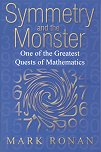This is the story of group theory, from the early days when Galois invented the subject, up to the present day with the identification of the "Monster" group, and a peer into the future with bizarre links to apparently unrelated branches of mathematics, and maybe even to physics. It is about the search for the complete set of all "atomic" groups (groups that form the basis of all the other groups), that mainly fall into a few neat families, with a few strange exceptions, including the biggest exception of the lot: the "Monster" group.
One thing I've noticed, reading this along with other books telling parallel stories (such as Fermat's Last Theorem and the Riemann Hypothesis), is the tragic similarities in the histories of all these essentially disjoint groups of mathematicians (except for the few very famous who crop up everywhere), and I wonder how on earth they managed to do any work. Europe was at war most of the time, and they kept moving round, and their contemporaries kept getting killed, right up to the utter devastation inflicted on German mathematics by the Nazis. Yet the ones that survived seem to have been supremely productive.
We get quite a lot of historical detail of the mathematicians involved here. (It is interesting to see a totally different explanation for Galois' death.) Now, I usually don't much like books that dwell on the personalities to the exclusion of the technicalities. But here, I'm not sure how much a non-mathematician would get the maths -- I already knew a little of the earlier stuff (if not the later) and still found it a struggle. But in some sense that doesn't matter. What we do get is a story of the sheer breathless excitement, of how mathematicians are drawn by patterns and beauty (and how it seems that most of the early mathematicians, at least, were completely bonkers!), with just enough of the flavour of the underlying maths to help ground it. We get to see the fevered excitement of the group theorists as they near completion of their task, and the bewilderment and skepticism of their non-group-theoretic colleagues, wondering if all these 200 page and 400 page proofs are proper mathematics.
And the end is quite intriguing, in much the same way as the end of Riemann Hypothesis story. There seem to be links between certain characteristic values of the Monster group, and some apparently totally unrelated number theory. Now, some of these might just be consequences of Guy's "Strong Law of Small Numbers", that "There aren't enough small numbers to meet the many demands made of them", and so coincidences will arise. But some of these numbers are big enough (20-odd billion) that mere coincidence doesn't seem to be the right answer. And then there are the possible links with string theory and why space many be 26-dimensional (related to a peculiarly compact packing of hyperspheres in 24d). There's something going on here...
